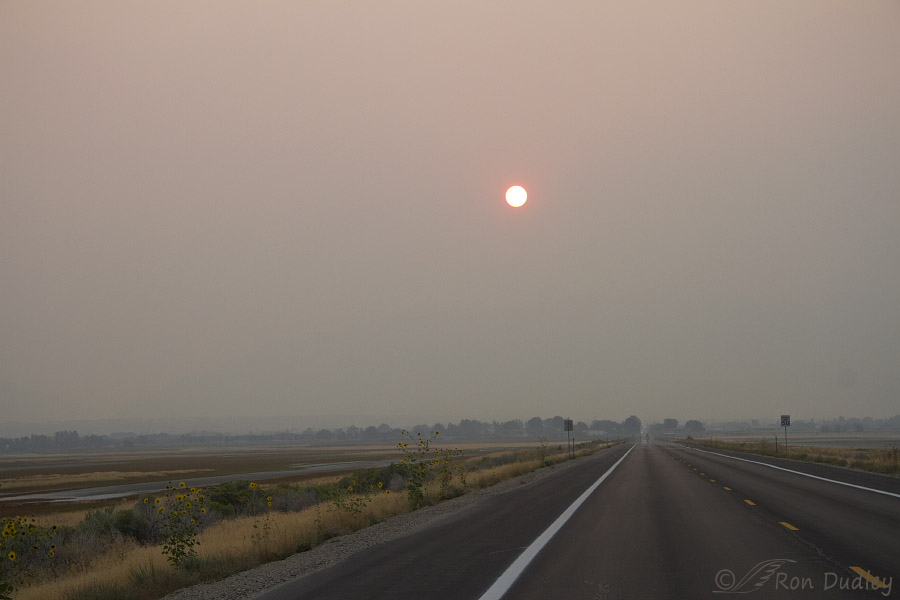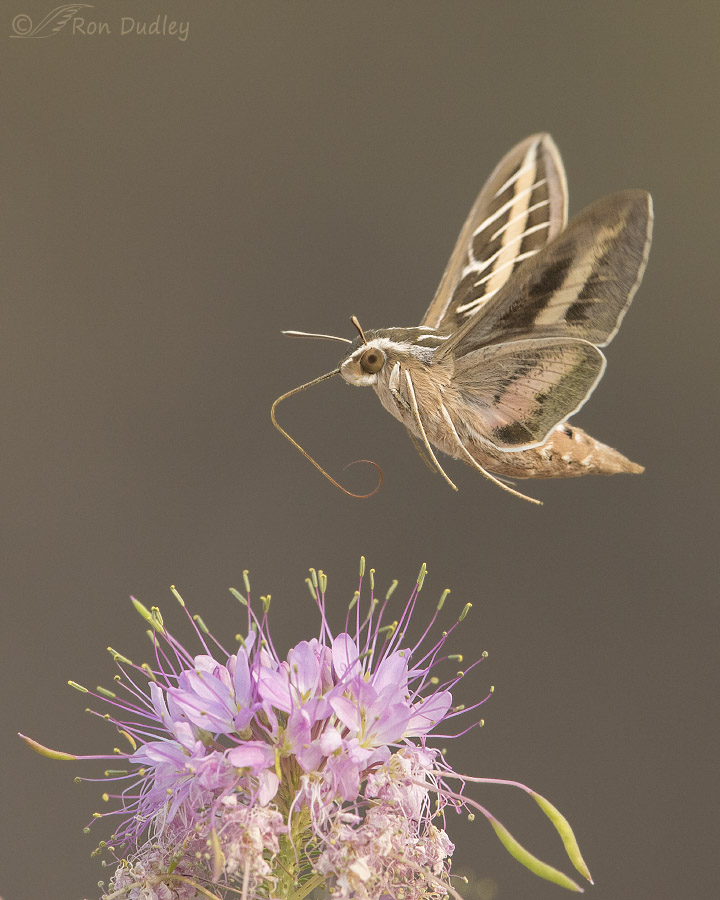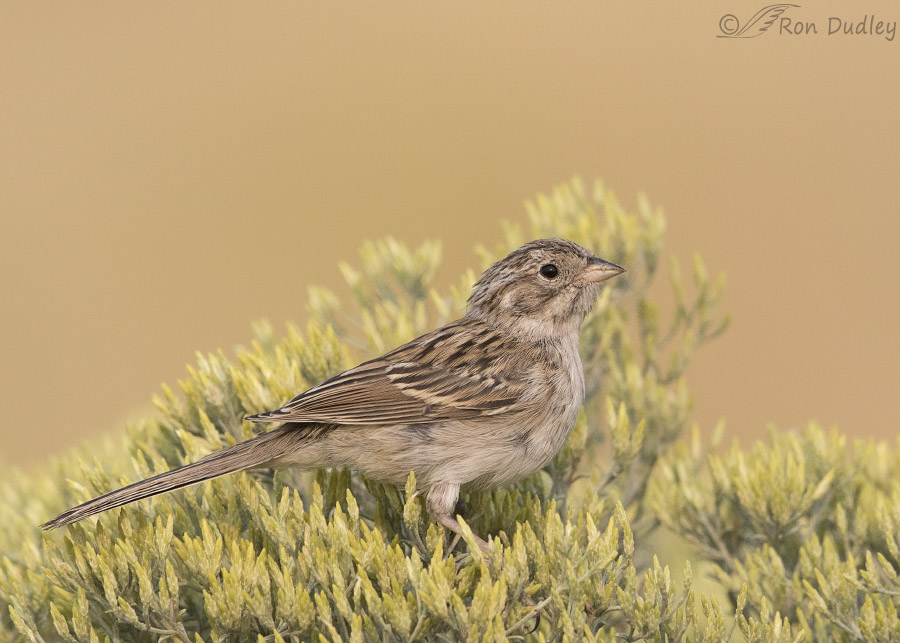And I’d appreciate some help from my readers in identifying the bird.
Yesterday morning on Antelope Island I got one of my favorite shots ever of a particular species and it wasn’t even a bird. But I very nearly didn’t go at all because of smoke from wildfires, both local and out-of-state.

This is the scene that greeted me looking east from the causeway about ten minutes after the sun came up over the nearby Wasatch Mountains. Several minutes earlier the sun had been a deep red but I couldn’t conveniently stop then and take a photo. Believe it or not there’s big mountains back there and they’re close but you really have to strain to even get a hint of them (if you squint they can barely be seen above the horizon on the left half of the frame). Our smoke is nowhere near as thick as folks in states north of us are enduring but it’s too damned thick for me and I hate it.
Needless to say I wasn’t optimistic about having enough light for the kind of photography I like to do.
1/4000, f/6,3, ISO 800, Canon 7D Mark II, Canon EF 500mm f/4L IS II USM + EF 1.4 III Extender, not baited, set up or called in
But by about 9 AM the sun was high enough in the sky that light didn’t have to penetrate so much smoke and I got a few shots of this juvenile sparrow on rabbitbrush (and in pretty good light) that I can’t identify. Sparrow ID has never been a strong point for me so I’d appreciate some help if anyone out there has a clue what species this is. I dislike placing any of my bird photos in my “Unknown ID” file…
Other than this sparrow I was skunked for birds. It’s been so hot that we’re still in the August doldrums in early September and it almost seems like a bird wasteland around here, except in the marshes. Eventually I parked myself in front of some Rocky Mountain Bee Plant and hoped to get lucky with hummingbirds or sphinx moths.

1/1600, f/6,3, ISO 800, Canon 7D Mark II, Canon EF 500mm f/4L IS II USM + EF 1.4 III Extender, not baited, set up or called in
Hummers eluded me but I did have some luck with the moths. This shot may become one of my favorites of a White-lined Sphinx Moth for a variety of reasons including the nice light and detail, the darker clean background, both moth and flower are sharp and I really like that partially deployed proboscis with pollen near its base.
And speaking of pollen – at the last minute I decided to include one last shot from my time at the bee plants yesterday morning. It’s only a documentary image but I think it’ll serve its intended purpose.

Some of the bumblebees working the bee plant were huge and they were after both nectar and pollen. Just look at the size of those two packed pollen baskets (corbiculae), especially the one on the left leg.
After all the time I’ve spent at bee plants over the last few years I’m hugely impressed by the amount of critter activity going on around, on, in and near them. Hummingbirds, honeybees, bumblebees, moths, butterflies, and a variety of other insects that I’ve forgotten and/or can’t identify seem to be either buzzing around them or crawling over them constantly.
What a service to nature and to all of us they provide!
Ron
Notes:
- I realize that only a very small percentage of insects are true “bugs”. I just like to use that term occasionally. Some folks refer to all insects and terrestrial arthropods as bugs but technically that’s incorrect.
- Interestingly (to me at least) there’s actually a fossil species of trilobite (a type of arthropod) called the Dudley Bug or Dudley Locust that was discovered in the limestone quarries of Dudley, England. My direct Dudley ancestors, including the Barons Dudley, owned and operated Dudley Castle in the town of Dudley during the English Tudor period.
- The oldest condoms ever excavated came from Dudley Castle. This from Wikipedia: “The oldest condoms ever excavated were found in a cesspit located in the grounds of Dudley Castle and were made from animal membrane, the condoms dated back to as early as 1642.”
I’m sure glad my ancestors apparently had some “accidents” back in the day or I might not even be here…



Of COURSE there’s a randy streak running through the Dudleys! I’d expect nothing less! 😉 At least some of you escaped “over the wall” (which could apply to the Tower or the condom!).
Beautiful shots of the flora, fauna, and landscape. I just wish that we could get gorgeous sunrises/sunsets without the smoke (of course, it’s the particulates in the air that scatter the light, but I digress).
Love the way you said that, Marty. And the randy streak continues!
Woo Hoo! 😉
Hooray for generations of happy Dudley ‘accidents’.
Proof that their best laid plans went awry even then.
Love the sphinx moth and the bumble-bee. Loathe thick smoky air.
And we’re still having accidents of various kinds, EC – gotta carry on the tradition ya know!
Your photography is always great. The informations about different species is as enjoyable as well. The history is great and you never know what you might learn from a bird blog. Condoms? Good laugh for the week. Thanks.
Yes, My post was a little eclectic today, even for me! Thanks, Betty.
Glorious images, well, except for the smoked landscape. That’s just awful.
I can’t help with the sparrow ID–I’m iffy on those, so you wouldn’t even be able to trust a SWAG from me. (SWAG=Scientific Wild-A$$ Guess).
Wonder if that Rocky Mountain Bee Plant would grow here? I’d certainly like to try! I’ve got a seed pod of milkweed that I’ll plant in the spring and hope for the best. Thus far, my initial gardening activities have failed miserably. That my rosemary died, actually TWO rosemary bushes, really hurt! They’re pretty darn hardy.
Of course, it’s not helping that I’ve also failed miserably at digging appropriate holes for planting, despite using a garden auger on a drill. Cody (my Brittany puppy) tries to help, and while he digs really good holes, none of them have been where I wanted to plant stuff. Sigh!
Between the fires and hurricanes, life is a little scary right now. I contacted my friends in Montana, and for them, the smoke is horrendous. Breathing is a challenge and they’re coughing regularly. They’re also worried about their (falconry) birds and dogs, along with all the surrounding wildlife. But they’re safe from the fires–for the moment at least.
I have so many friends in danger’s way both from Harvey and now Irma, and while Harvey was horrific, Irma threatens to top it in ferocity, especially for my friend who lives in the Florida Keys. The Keys might very well be wiped off the map from the storm surge if they get a direct hit. Even a glancing blow could do it. The only good news I can see is that Irma will yank some of the warm-water feeding system out from underneath Hurricane Jose by churning up the cooler water from below.
Darn, got distracted. I LOVE your Dudley history! And that they survived Tudor England was a feat unto itself, condoms aside 🙂
Laura, Not all of them survived. Two of them, John Dudley and Edmund Dudley, were beheaded at the Tower of London.
Do you know the when part of the beheadings? Did it happen under Henry VIII (disagreed with his divorce from Catherine of Aragon, his break from the Catholic church and s/he refused to sign the Church of England/divorce agreement?), during Edward (who didn’t live a long time) or under Bloody Mary when it was a very bad thing to be a non-Catholic and she went on a beheading spree? Interesting how these folks aren’t really considered serial killers, isn’t it?
I visited the Tower of London and tried to stand in the tiny chamber where Mary Queen of Scots was held. I couldn’t do it. I’m guessing it was only about five feet tall. Mary Queen of Scots was a falconer and Elizabeth released her daily to fly her Merlin, at least until their conflict deepened and Mary got on Elizabeth’s last nerve and had her beheaded. Mary’s son, who became James I of England and James II of Scotland continued the falconry tradition. I have a photo of his gauntlet that survived the years. I KNOW he never fed a bird on that glove. It’s not all skanky like mine. Instead, it’s a light leather that’s beautifully embroidered. No blood and miscellaneous gore 😉
Yeah, I have a thing for history. I’m exploring the idea of doing a doctoral program in Native American history. There are some cool NA faculty members at ASU! If they have a distance program, I’m in!
COOL LAURA, VERY COOL!!!
“Do you know the when part of the beheadings? Did it happen under Henry VIII”
Yes, Edmund Dudley, Speaker of the House of Commons, was beheaded under Henry VIII. https://en.wikipedia.org/wiki/Edmund_Dudley
John Dudley, Duke of Northumberland, was beheaded under Queen Mary I (Bloody Mary). –
https://en.wikipedia.org/wiki/John_Dudley,_1st_Duke_of_Northumberland
Edmund was John’s father. I don’t think the Tudor’s liked my family…
Laura, here in the Chihuahuan desert we have Poison Milkweed, which does very well (although I think it needs some regular water). It attracts tremendous numbers of insects – mostly wasps of various kinds, and some beetles and probably butterflies. It’s definitely worth trying to grow your milkweed.
THANKS Susan! I’m new here so have to learn a whole new ecosystem. The milkweed I have is from a plant in Denver, so don’t know if it’s a poisonous milkweed or not, but it attracted a lot of hummers, along with bees and other flying critters. It was a beautiful flower cluster. I should have planted it this spring, but I didn’t have the house until April and had other tasks scheduled ahead of gardening. 😉
Love your sphinx moth!!!!! The smoke is making me ill!!!!!praying for rain!!!
Thanks, Marina. And yes, it’s awful.
Sparrow ID is easy…it’s obviously a LBJ…glad to help….
Thanks so much for that expert ID, Patty! 🙂
Your Dudley history left me chuckling. Thank you for that. Also, I appreciate the explanation about true bugs – I find myself explaining that a lot when we see true bugs on our tours out at Hueco Tanks. We’ve been seeing a lot of them lately. The White-lined Sphinx photo is gorgeous. The plant we have here that attracts the same huge variety of insects – especially wasps – is the Sotol. The blooms are on a very tall stalk and are dense, which allows lots of insects to visit at the same time. That can be quite spectacular.
Susan, I used to always correct my students when they used the word “bug” inaccurately and here I am doing exactly that. Some of them may give me a little grief about that if they see this post (and many often do)!
Hey Ron– it’s certainly a juvenile Spizella, and on the whole, I agree that it looks best for Brewer’s because the dark line does not continue in front of the eye, there is a pale malar stripe offset by thin dark lines, and the bird overall doesn’t have much contrast or color. If it had a pale ring around the eye, I’d feel certain, but I guess I can’t have everything!
Thanks for going into some detail regarding the sparrow ID, Brian. The lack of an eye ring is one of the things that confused us.
Good to hear from you again!
Thanks for the great shots (as ususal), and the funny Dudley trivia!
I’m glad you enjoyed that trivia, D.
Hi Ron,
I would say Brewer’s Sparrow. And, that smoke is ALL over the west – here in southern OR, the local hardware store is selling masks like crazy, and everyone is driving (if they venture outside) with their lights on. Reminds me of those news images we used to see from Beijing. There are, of course, bigger problems in the world, but…
Cheers,
Dick
Dick, thankfully we haven’t yet reached the point where we have to drive with our lights on during daytime. Hope we don’t in the future!
Thanks for the confirmation of the ID of my sparrow.
Love the sphinx moth and bumble bee – always amazes me how much pollen any be can carry. The bee plants do provide a great service to many – including a photographer! 🙂 Had a good chuckle over the Dudley family history! 🙂 We’ve had a couple of days reprieve from the smoke tho it started slipping in again yesterday and this morning – not as bad as it was but the red sun is a VERY familiar sight at sunrise and sunset of late – moon was nice and red when it rose the other evening. It does go “fast” so being able to stop/go get the camera is often TOO much time. Rescued? a bunch of minnows from a puddle on Belt Creek yesterday – they made short work of the aphids on the water lily pads in “pond” a.k.a. stock tank. Hopefully there is water to put them back before winter as suspect they won’t do well in the aquarium!
Judy, my family history includes some darned interesting events and people. Every time I do some research I stumble onto something new and sometimes bizarre.
Today the smoke here is noticeably improved but it’s still pretty bad. Nothing like you folks have been putting up with though…
Great series Ron! I’m not good with sparrows sorry.
Charlotte
Thank you, Charlotte.
Love your moth and bumble bee images. If I had to guess on the sparrow, I’d go with Brewer’s. Your images looks a good bit like the juvenile Brewer’s in Figure 20.6 of Beadle and Rising’s “Sparrows of the United States and Canada–The Photographic Guide.”
Thanks, Ron. Brewer’s seems to be the overwhelming consensus, both here and on FB.
I enjoy your narrative and photos everday Ron. Have you tried Cornell’s Merlin Bird ID’s new photo ID option to identify the sparrow? I have had good luck using it in the past although never with a member of the often frustrating sparrow family much less a juvenile family member.
It is so sad to see the path of the wildfires in Montana. My dear friend and next-door neighbor grew up in Plains, Montana and is just devastated by what is happening there.
Be well and stay safe. I hope you are able to solve your juvenile sparrow mystery.
I haven’t tried it, Linda. Not yet…
Brewer’s Sparrow
Thanks, Brad. This one had me stumped.
Quite good for the type of day you had. Great shots, I particularly like the moth and Bumble Bee!
The air quality can’t be good where you are, it is even crossing the US and affecting parts of the East!
Stay safe!
Thanks, Dick. Smoke sucks!